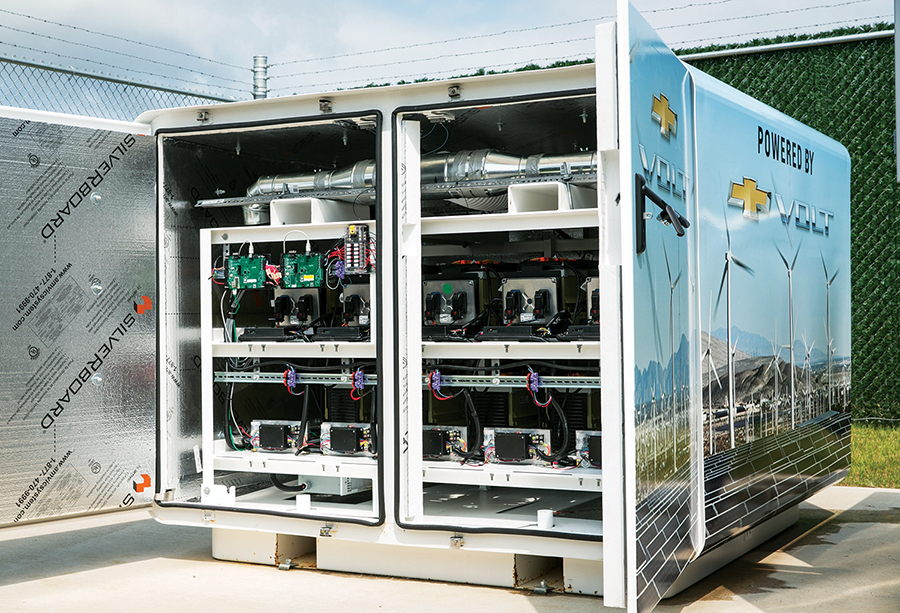
General Motors used old Chevrolet Volt batteries to help supply power to its administrative offices in Milford, Michigan. Photo by John F. Martin.
Already plentiful in electronic devices, batteries also power an increasing array of products formerly operated on fossil fuels. Many of them, from smartphone batteries to those in electric vehicles, are designed to be rechargeable, but they don’t last forever. At some point they become too worn out to do the job they were built for.
For small electronics, recycling is the desirable endpoint, although rates are still distressingly low according to many estimates — it’s just too tempting to discard them along with other trash. However, it’s not going to be easy to handle depleted electric vehicle batteries so casually. They’re large and very heavy — “they won’t be dumped in the backyard,” joked Dale Miller, president of the Golden Gate Electric Vehicle Association.
Instead, as the first generation of these batteries begins to age out, with larger waves to follow, vehicle manufacturers and regulators are planning ahead for what happens to them when they move on to their “second life.”
Miller observed that car manufacturers are selling to a world market, so mandates in one country require solutions that may eventually be applied world-wide. In the European Union and China, “cradle-to-grave” regulations require manufacturers to take back depleted batteries or provide for disposal, so pilot projects and trials for doing this responsibly and cost-effectively have been underway for some time.
The first option is re-use, because batteries that are too depleted from recharging to adequately power a vehicle may still have quite a bit of oomph left. In Japan, Nissan powers streetlights with re-used batteries. General Motors uses them as backup power for administrative offices at a Michigan data center. At BMW’s Mountain View offices, the automaker collaborated with PG&E to develop a solar-powered energy storage system using eight repurposed car batteries.
EVgo, which provides fast-charging stations for electric vehicles, is powering a station in Union City with re-used BMW i3 batteries replenished by solar power. Fast-charging uses a lot of power and can incur surcharges from utilities when done at peak demand times. Using batteries can level out the draw on grid power, significantly reducing surcharges.
Of course, old batteries can’t just be swapped straight into a storage system or charging station. As Harmeet Singh, CTO of charging infrastructure company Greenlots, explained at the Storage Week 2018 industry conference, “Electric vehicle battery packs have modules, and modules have cells, and not every module and not every cell degrades uniformly. There is an effort required to repurpose the right modules and the right cells into the second-life battery pack. There are costs associated with that.”
Although second-life battery systems scored high on both cost-effectiveness and ease of adoption in a 2018 Bay Area Air Quality Management District report on technology to reduce greenhouse gases, the report cautioned that “the technology and vendors are still very young and higher production levels are needed to lower costs and achieve economies of scale.” Currently, companies who are developing re-use and recycling programs work with defective or damaged batteries, or new batteries used in durability tests or demonstration vehicles. By 2025, research organization Bloomberg New Energy Finance estimates that 27 percent of used vehicle batteries will have some useful second-life applications.
Eventually, batteries will become unusable at the end of their second life, but will still have some residual value. Some source materials for the batteries, such as cobalt, are expensive and obtained from parts of the world where mining may be exploitative of both workers and the environment. Reducing the use of new materials by recycling batteries can bring down financial costs and decrease the need for harmful sourcing practices. However, with increased production and new technologies, electric vehicle batteries are becoming steadily cheaper, which may make materials recovery less cost-effective than making new batteries from scratch. Recycling then becomes driven by other factors, such as cradle-to-grave regulations.
Most electric vehicle batteries are lithium-ion (Li-ion), chemically similar to those used in small electronics and household devices. The usual recycling method for small batteries has been to crush and smelt them to extract the most valuable materials, but many companies are exploring alternative techniques for recycling the much larger batteries in electric vehicles. For example, battery recycling company Retriev Technologies manually disassembles them and then uses a chemical process to extract metals.
An Argonne National Laboratory factsheet on battery recycling points out that the components of Li-ion batteries can vary by manufacturer, requiring multiple approaches to recycling. CalEPA has just seated an advisory panel, the Lithium-Ion Car Battery Recycling Group, as required by 2018’s Assembly Bill 2832 (Dahle). Its report on options for recycling in California is due by April 2022.
The Golden Gate Electric Vehicle Association’s Miller observed that the plans for older batteries may be premature, and possibly even unnecessary, given 1) the percentage of vehicles that are electric, 2) the predicted more than eight-year life span of the batteries, and 3) the possibility that with accelerated research into battery technology, Li-ion batteries may be superseded by something new.
“It’s an anticipated need, not a current one. We’re about ten years into the third set of electric vehicles,” he explained. “We have [association] members still driving cars with Ni-Cad batteries. The current set — Tesla batteries, in particular — are lasting a lot longer than predicted.”
Miller expects that used electric vehicles, often purchased as commute vehicles with low daily mileage, will work for many years. In California, electric vehicle manufacturers are required to warranty batteries for 10 years or 150,000 miles. Nevertheless, there will be large numbers of batteries that must be dealt with in the future. The International Energy Agency predicts the number of electric vehicles around the world could grow from about 2 million in 2019 to as many as 140 million by 2030, and California is on the leading edge in the United States.
Given the many times in the past when an innovation was supposed to solve one problem but created others (the MTBA gas additive comes to mind), it’s encouraging to know that electric vehicle batteries are being planned for throughout their life cycle. Miller commented, “Most of the [electric vehicle] drivers I know are not really worried about this; although they are concerned about the environment, they are comfortable that this will be taken care of in a responsible way.”
Leslie Stewart covers air quality and energy for the Monitor.

